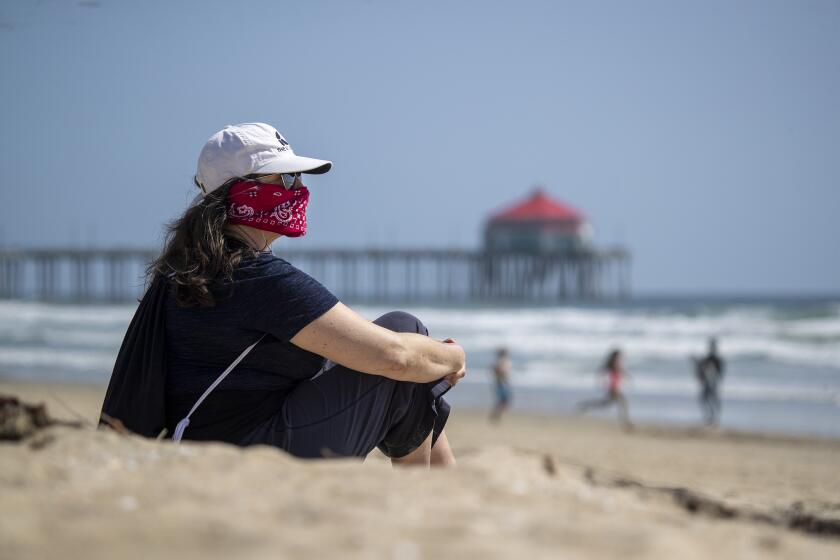The Bell Curve: Harvest of hope, memory lives on
Editor’s note: Due to an editing error, The Bell Curve failed to appear in Thursday’s Daily Pilot. It appears in full below.
Memorial Day — we called it Decoration Day when I was growing up in Indiana — has come and gone, and seemed more full of urgent memories and intensity this year than ever before. Maybe that’s because I feel closer to the Civil War as I grow older. There is an increasing awareness as I distance myself from it that I was only two generations away from the violent remnants of slavery in this country, a sobering thought whenever I allow it in.
My grandfather, Robert Patterson, was a colonel in Gen. William Rosecrans’ Army of the Cumberland. He was wounded in fierce fighting around Murfreesboro, Tenn., and I have a letter he wrote from his hospital bed to the woman back in Decatur, Ind., who became my grandmother. And I never fail to marvel that I shared this Earth for five years with Robert Todd Lincoln, the oldest son of Abraham Lincoln, and the only one to live into maturity.
Decoration Day was created to honor the memory of those who fought to preserve the American Union and — not incidentally — to free the three million men and women trapped in a system that allowed and supported their enslavement as property to be owned and used. Although Decoration Day has acquired a different name and now includes the casualties of all our wars, the Civil War carnage continues to dwarf all the others combined in its carnage.
There were 610,000 soldiers — 2% of the U.S. population at that time — killed in action, as compared with 0.3% in its nearest competitor, World War II. Many Civil War veterans and their families are — like my grandfather — buried in the Decatur cemetery. My parents are there and I will be, too, so that anyone who comes to visit me will find themselves on a Midwestern hillside overlooking my extended family and my beloved Indiana.
These were the sort of connections that brought us together on Decoration Day in my youth. There was always a family picnic in a local park, followed by the same speech, year-after-year, called “Our Flag.” It was delivered by my uncle, French Quinn, who had never been in a war. Then we would repair to the cemetery, loaded down with flowers to plant on the appropriate grave sites.
My grandfather died a dozen years before I was born, but my various uncles — my grandparents had five daughters, all very much in demand — delighted in repeating the increasingly creative war stories the old man told when he held court on his front porch for his potential sons-in-law. As I grew older, I regretted more each year that I came along too late to hear those stories in person. So I compensated by collecting a Civil War library in my office. And when I ventured into writing fiction, it was to construct a novel around a planned breakout of 10,000 Confederate war prisoners being held in Chicago that really happened and almost succeeded. The book, so far, has been read only by members of my immediate family — well, most of them — and a passel of agents who have turned it down.
But hope lives on. And I will continue to harvest memories of Memorial Days right up to the one last week when two Congressional committees repealed the disgusting “don’t ask, don’t tell” policy that made it impossible for gay and lesbian Americans to serve in our armed forces on an equal basis. I would hope that the military brass now meeting in Washington to confirm this long overdue action would be required to read the late Sen. Barry Goldwater’s take on this subject that starts out: “It’s no great secret that military studies have proved again and again that there’s no valid reason for keeping the ban on gays.”
The movie and TV royalty that I wrote about during the 15 years I spent covering Hollywood are dying off almost weekly, leaving behind more memories — mostly pleasant and often vivid. One who left both died last week.
On the surface, Art Linkletter was a lightweight thinker, working early on with kids who supplied his richest material, then shifting to motivational speaking and finally turning both specialties into highly profitable businesses. That was the limit of my knowledge of him when I was first assigned to do a profile of him for a national magazine. And never had I been more wrong.
All of this came back to me when I pulled my Linkletter file and got reacquainted with him. Never far distant from his thinking was the suicide of his 20-year-old daughter, Diane, which he blamed on an LSD flashback frenzy. It set a course for Linkletter, from which he never wavered, to define and attack drug abuse out of knowledge, not emotion. In this process and his subsequent motivational speaking, I never detected a phony word or action.
“The idea of my being old,” he once told me, “is the last thing I ever think of. I go to these senior citizen places to comfort people and suddenly realize I’m older than a lot of them. It’s all in your attitude. You must set goals no matter how limited they are, and when you get to them, try the next thing. If you were to sit back and look at it coldly and dispassionately, you’d say this is like made work. Not real, so it isn’t important. But that’s not true as long as it is something to hope for.”
So R.I.P., Art Linkletter. You’ve helped build a myriad of hopes. And you’ve earned a rest.
All the latest on Orange County from Orange County.
Get our free TimesOC newsletter.
You may occasionally receive promotional content from the Daily Pilot.



